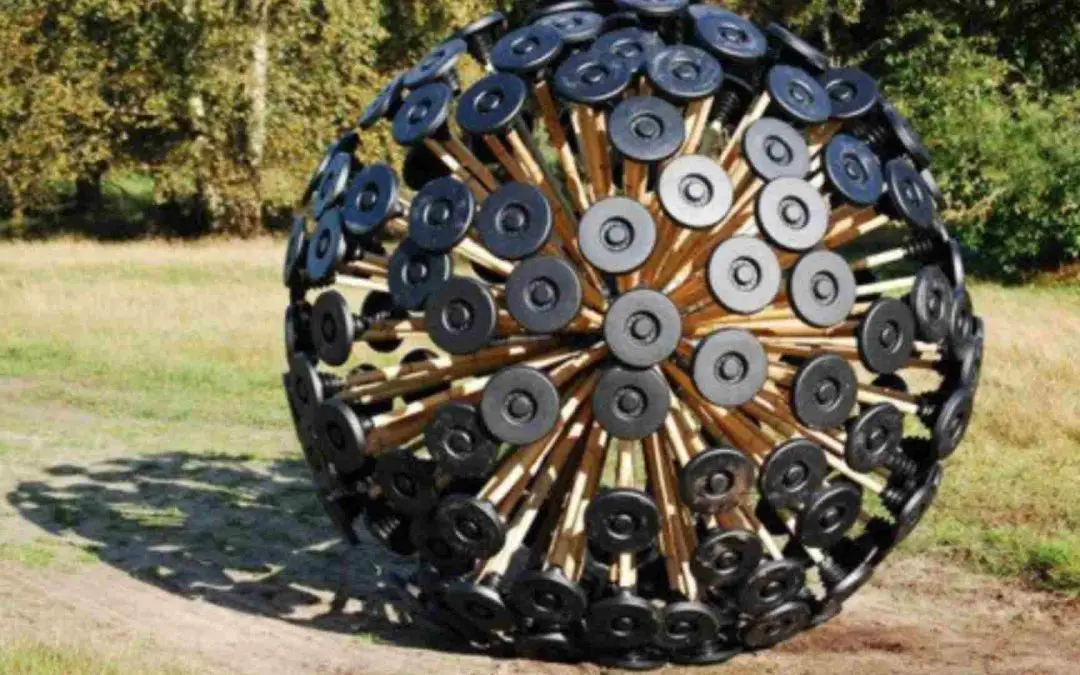Bamboo feeds, houses, decorates, and it can even save lives. Growing up in Afghanistan, inventor Massoud Hassani used to play in raging war zones and fields studded with landmines. He and his brother would construct small spheres from scrap metal that would roll along the desert floor, powered by the wind. Sometimes, their contraptions would travel dangerously close to the bombs. And that’s how he came up with the Mine Kafon.
The Mine Kafon Drone is a remotely operated device that rolls like a tumbleweed to detect and detonate live landmines in former war zones. The original Mine Kafon, made from bamboo, iron and plastic, was not remotely powered but relied only on the wind to move across the minefields. Afghanistan-born inventor Massoud Hassani established the Mine Kafon Foundation in 2013, in Eindhoven, Netherlands, to promote this invention as a tool to make life safer in war-torn regions.
The story behind the bamboo minesweeper
Massoud Hassani was born in Afghanistan and grew up in the interwar period between Soviet and American occupation. When he was 14, his mother arranged for him and his brother to be spirited out of the country by smugglers. They arrived in the Netherlands where Massoud adjusted quickly and eventually enrolled in design school.
For his final project at the Design Academy of Eindhoven, Hassani drew upon his childhood experiences to create a giant version of his old playthings. Nearly 20 times bigger than the original, the heavier and sturdier Mine Kafon was made from bamboo and biodegradable plastic. Propelled by the wind, they could meander through dangerous terrain, saving lives with each mine they trigger.
It has been estimated that through conventional methods, it costs up to $1,200 to remove a single landmine. Hassani’s design cost only 40 Euros, and it could be used multiple times before needing to be replaced. With every explosion, the Mine Kafon loses only one or two legs, allowing it to keep moving and remove up to three or four explosive devices in a single journey. Hassani would track his inventions by GPS, monitoring their paths and keeping tabs on how many bombs they cleared.
Hassani’s work has toured the MOMA in New York as well as the Gallery Slott in Paris. Visit the link to see the Mine Kafon in action!
Evolution of the Mine Kafon Drone
Innovative and affordable, Massoud’s invention caught on quickly. In 2013, he established the Mine Kafon Foundation to raise money to replicate more of the dandelion-shaped contraptions. The original design was especially effective on open desert terrain, not so much on the verdant hillsides of Southeast Asia. Its reliance on the wind resulted in certain limitations.
As the Mine Kafon Foundation succeeded in bringing attention to the invention and raising money for production, the design crew began implementing modifications. Most notably, they added drone technology to make the minesweepers remote controlled, resulting in more thorough and efficient detection and removal of explosives.

Landmines remnants of war in the modern era
To this day, there remain an estimated 100 million active landmines buried in more than 60 countries around the globe. According to the UN, about 20,000 people get killed or maimed every year by these lingering weapons of war. The most common means of mine removal are by trained experts, dogs and armed vehicles. These techniques continue to be expensive and very dangerous.
In Vietnam, farmers and scientists are currently using bamboo to neutralize another remnant of armed conflict. During the Vietnam War – or what my friends in the country refer to as the American War – the US military dumped vast quantities of Agent Orange and other “tactical herbicides” over the farms, villages and countryside. The toxic defoliants contaminated and denuded countless acres and poisoned millions of Vietnamese people.
Major swaths of land, especially in the central highlands of Vietnam, remain unfarmable because of these toxic defoliants. But farmers are discovering bamboo, with its impressive capacity to purify water and remove toxins from the soil, is able to restore the land and make it safe again for farming. Researchers are currently examining which species of bamboo are most effective, what parts of the bamboo store the toxins, and how long this process of remediation takes. It’s an especially exciting area of bamboo research that we are tracking closely.
NOTE: This article originally appeared in November 2012, courtesy of Morgana Matus, and was revised in April 2022.
Knowledge is power
From landmines to landslides, chopsticks to chocolates, it seems there’s nothing you can’t make or improve through the use of bamboo. Learn more about the incredible potential of this abundant grass in some of our other in-depth articles.




















